Contents
1. Need and Support: The Meeting of The Concrete and the Abstract in the Late 1990s and Early 2000s Sculptures by Maija Helasvuo, Tutta Palin
2. Maija Helasvuo, Sculptor, Mika Karhu
3. ‘Different traumas’ – Maija Helasvuo’s sculptures, Jan-Kenneth Weckman
Need and Support: The Meeting of The Concrete and the Abstract in the Late 1990s and Early 2000s Sculptures by Maija Helasvuo, Tutta Palin
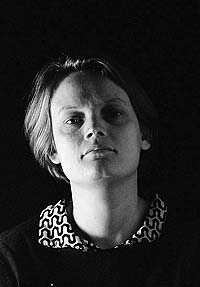
One of the problematics that have recently attained hightened actuality in the field of contemporary art has to do with trying to grasp the ungraspable. It feels, right now, increasingly important to reflect on the possibilities of giving precise visual expression to what is vague, unstable, or ambivalent. How could this be realized so that the expression itself would not be insecure and indefinite? Can the artist, in fact, address the state of helplessness without becoming helpless and inarticulate him/herself?
The sculptural works of the recent years by Maija Helasvuo partake in this discussion in a very graspable, down-to-earth manner. Her supports – for the chin, the thumb or the hand, for instance – bring up the question of bodily helplessness in a warmly playful tone. The wooden supports look comfortable in spite of their very slender legs. Albeit close to being visually unbalanced, they are strong in their structures. A support of hers made of metal can, on the other hand, look very delicate and unassuming. One only dares to lean on such a paradoxically light support once one has been granted the information that it is, indeed, quite firm. Even though the visitors to a show are not encouraged to touch the sculptures with their hands and bodies, it is possible to ”touch” and explore them visually. In the terms of art theory, we could say that they produce a viewing position that is bodily located in place and time, with respect both to historical time and to social situation.
The corporeality of the viewer should, in fact, be something self-evident in the context of sculpture where the three-dimensionality of the work of art forms an obvious spatial continuum with the viewer. The spectators who are used to frequenting art shows are, however, at least partly, trained to use a distanced gaze through which works of art take form in a sort of a neutral ”non-space”, resembling the standard-size illustrations of art books. The Support series on which Helasvuo has worked since the year 1997 makes the viewer reflect on the relationship between bodies and spaces: Whom are these supports made? Who can use them? Am I of the right size? In our daily life different kinds of supports tend to be manufactured after individual measures or, one can at least choose between different standard sizes. On the other hand, many things that we need, including garments, mould themselves after their user. Even objects made of wood become inscribed with marks of usage. A sitting mark worn into a stool in the course of time touches us in its intimate bodiliness even when the stool has ended up an anonymous and impersonalized object in a museum.
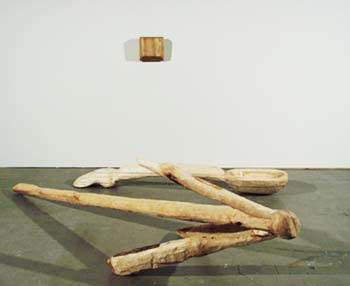
Hunger I-IV , 2000-2002, pine, alder, oak, aspen
But Helasvuo’s Support series raises further questions. Do I need this? What is, ultimately, absolutely necessary? The three-part work called Hunger (2000) also comments on the baffling inconstancy and cultural variability of human needs. Nutrition, one of our so-called primary needs, can become so matter of course to us, that it is transformed into a cultural surplus or even into an object of industrial design. This does not mean to say, however, that the newly created needs would not be acutely felt on a personal level.
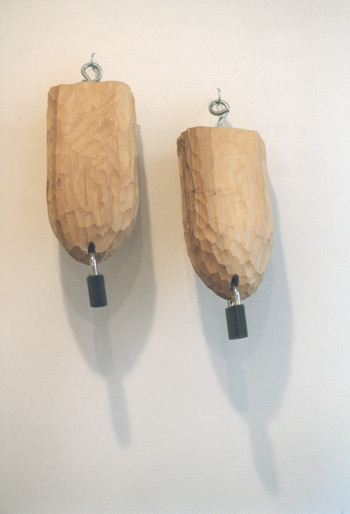
The Fourth Day of Breast-Feeding, 1998, alder, stone, iron, height 45 cm
The Fourth Day of Breast-Feeding (1998) can, of course, as well be associated with nurture and human needs. This work refers to bodily weight in general and, more specifically, to motherly nursing. In fact, the concept of the ”locks” of the fourth day of breast-feeding which prevent the milk from coming and make the breasts as hard as stone, is most probably only known to women who have themselves nursed an infant. This concept is an excellent example of the specific locatedness of our bodily existence; there is no generic, abstract human body, there are only specific ways of being in the body that take shape in lived experience. Different individuals are therefore differently situated with respect to, for instance, the classical nude to which some ot the details of the organic forms of Helasvuo’s art seem to refer. In this way the re-concretization of the abtracted, classical body has important political implications.
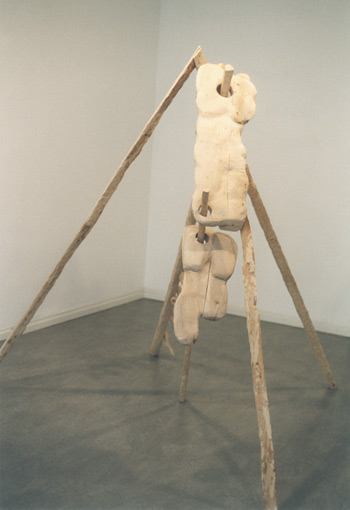
Group, 1998 – 1999, alder, height 2 m
The Group (1998-1999), for example, includes two female torsos that have been stretched into a balance at utmost risk.
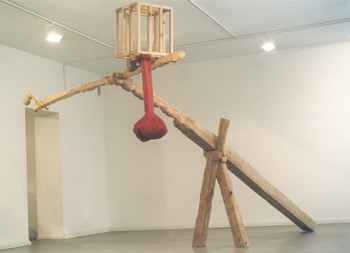
Insolence,
1999, alder, plastic canvas, height 250 cm
Insolence (1999) is similarly constructed according to a very special delicacy of balance, conveying the co-existence of infirmity and firmness; even the greatest security is based on constant work of supporting and on the principle of carefully concentrated balance. Its materials also contradict each other in a strained manner when the everyday nature of the plastic-surfaced textile, identified with women, challenges the woodwork that is traditionally coded masculine. The juxtaposition of these materials is historically anachronistic and associatively arrogant, yet visually fresh and easily accessible. The same kind of joyful ambivalence characterizes many of Maija Helasvuo’s sculptural works.
Tutta Palin
Maija Helasvuo, Sculptor, Mika Karhu
At the centre of Maija Helasvuo’s art, are the different levels of human feeling. Her sculptures picture peoples basic emotional dynamic; loss, vulnerability, closeness and our dependence on social interaction. Each person is a part of the complete community of humanity. Through communal experience and all the social forms within it, the process of an event is formed, the connection and interaction of which makes up the whole content of human society.
That which acts on the powerful emotions inside society as a directing force is in one way or another a common factor and causes a process of emotional adaptation. Things that happen in our environment affect us. Helasvuo’s sculptures picture this invisible influence, which is at once adaptable and concrete.
Mika Karhu, Ph.D.
Text in German:
Maija Helasvuo, Bildhauerin
Verschiedene Ebenen menschlichen Fühlens sind zentral in Maija Helasvuos künstlerischem Werk. Ihre Skulpturen machen grundlegend menschliche emotionale Dynamiken sichtbar: Verlust, Verletzlichkeit, Nähe und unsere Abhängigkeit von sozialer Interaktion. Jede Person ist Teil der Gemeinschaft aller Menschen. Durch die gemeinschaftliche Erfahrung und alle möglichen Formen der zwischenmenschlichen Interaktion nimmt ein Ereignis prozesshaft Form an, alle Verbindungen und Interaktionen in solchen Prozessen bilden die Gesamtheit der Bedeutung menschlicher Gesellschaft.
Das, was auf starke Emotionen innerhalb der Gesellschaft als richtungsweisende Kraft einwirkt, ist auf die eine oder andere Weise ein verbindender Faktor und löst einen Prozess emotionaler Anpassung aus. Was in unserer Umgebung stattfindet, hat einen Einfluss auf uns. Helasvuos Skulpturen stellen diesen unsichtbaren Einfluss dar, der gleichzeitig wandlungsfähig und konkret ist.
Mika Karhu, Ph.D.
‘Different traumas’ – Maija Helasvuo’s sculptures, Jan-Kenneth Weckman
I am in Romania, in the centre of the medieval town of Sighisôara, climbing the hundreds of steep steps to the church and protected from the rain under a long covered way. Later I recall the wooden shapes of the Lutheran church on the hill, the cracked figures on the pew doors and the time-aged votive chest. I hear time flowing organically through the seasons and the centuries. Urban culture easily destroys all things organic, erecting its own new geometric signs. Steel, bronze – or plastic – do not rot. Wood rots, it moulders and decays. Though paint may slow the decay of a Finnish wooden church, it too is part of the world like we frail humans. I feel that Maija Helasvuo’s wooden sculptures – as though turned by a huge powerful hand – enter this world.
Maija Helasvuo’s journey to being an artist was saturated with culture. “I marched with my parents from one church to the next.” Functionalism, modern art, architecture, design and folk crafts, all were admired in the Kaj Franck spirit. An architect father and an art teacher mother could hardly fail to influence the background from which the sculptor strained to break loose. The artist does not vacillate on her journey into the past and via it into the present, to a belief in existence and the absence of this belief, likewise its mercilessness – and its humour.
As a mundane, arte povera material, wood trivialises the holy and eternal in sculpture, but as an art form retains its potential to tell about strength and weight. Modern sculpture hones and patinates its material to express lightness and immateriality. I’m thinking in particular of the many Finnish sculptors from Pullinen to Tapper. However, through her organic world view and its various dimensions, Helasvuo takes her stand without avoiding the impression of weight. It is as though the artist repudiates her own rules by appealing to the possibilities of lightening the imagined weight of wood. Weight is connected to the absurd as with the colossal utility objects in the Hunger series from 2000. Or with the work Coincidences, which caused the Karjalainen magazine’s critic Leena Leskinen-Myller to label Helasvuo “the Eeva Ryynänen of the grotesque.” Ideas pop up from the way we appraise and use different varieties of wood: the common alder, aspen and pine, like the more valuable woods, provoke motifs and spur the sculptor’s imagination, producing hamburger boxes from oak and spoons from pine.
It is no easy matter to assume the role of artist and Helasvuo makes a statement with Cranium-Feminine, sculpting herself out of the Kaj Tapper romantic tradition. This magnified wooden uterus, complete with ovaries, stands as a challenge to the heroic male. Material and narrative form a unity. Together, wood and form suggest a cyclical theme, the basic conditions – and suffering – of the world that is being constantly rebuilt. The heritage of a masculine profession is ripped away from the ecstatic fascination, the sublimity, of the central modernist (male) ideal. Helasvuo does not precisely indicate her position on the art map:”Louise Bourgeois’s art is closest to me. I appreciate her work, but not her traumas; my traumas are quite different,” says the artist laughingly. For Helasvuo, the images of faith, Christ, Pietà, translate into ordinary images. The artist observes: Medieval church art can be generalised into images of things all of us confront in life, sacrifice (The Crucifixion), loss (Pietà), sheltering (Maria).” The maimed figure of Christ includes connotations of pious touching. The variety of wood changes, the surface is smoothed. At first, the artist offers grotesque humour, but only as a part of the transgression. Next is humbleness, submitting to the human condition.
In recalling our conversation, I add to my own list: mother rejection, mother substitutes, symbols, substitutions, autarchy, autistic withdrawal, sublimity. Are these the modern resources of male authorship? It is true that the state of sublime (terrifying) alienation (from oneself/nature) has mainly been charted by men, such as Samuel Beckett, Surrealist, painters like Barnett Newman and Cy Twombly, and theoreticians like Adorno, all ultimately powerless against the growing sublimity of modern urban space that, for example, Sophia Coppola so finely epitomises in her film Lost in Translation about the urban landscape of Tokyo. The global sublime is a cultural contradiction impossible to translate, covered (as an impossible) unity beneath the imagined surfaces. The cultural sociologist Jean Baudrillard talks about the collapsing structures of early signification. The sublime vanishes from the path of simulation, in the culmination and dizziness of the sublime. The sublime can no longer be linked to the dark starry night, the landscape of the full moon or the mercilessness of natural phenomena. The sublime has been transferred to the power structures made natural by man, in which the individual’s relation to tradition and the past is broken. Similarly, the future is fractured into modern fragments. By seizing man’s corporality as the measure and model of art, Maija Helasvuo sculpts open the contradiction between the continuity of tradition and modern fragmentariness.
For Helasvuo, the grinder, chisel and axe are her pencil and eraser. I try to think of her work as forms erased from some hard substance. Form always means something, but different things. As the object of our observation, form means what we can read into it. To literacy belong repetition, feeling, conjecture – and remembering. Helasvuo is not a non-figurative artist because the shaping of a figure is not simply a question of finding a figure but its expressivity. Nevertheless, the connection to abstract art is ambiguous, mischievously close. In contemplating Helasvuo’s work, art researcher Tutta Palin suggested that the artist is capable of giving a precise expression to the unstable, a kind of uncertain abstraction. In her text, Palin constructs an analogy between the concrete and the stable, the abstract and the uncertain, which the critic Marja-Terttu Kivirinta uses in her review of Helasvuo’s work. And if one might add: a transition to informalism in art. Here, however, informalism is both an apt and an inapt term because the relationship between the synonyms abstract and non-figurative is shattered in a curious way in Helasvuo’s art. The first, non-figurative impression soon acquires the accentuated presence of figurative aspects which soon develop into surprisingly realistic features. Admittedly, we do not need much to awaken our memory of the physical environment around us: away from the uncertain and the abstract towards the concrete. Another condition for interpretation is, as with Cranium-Femine, some supplementary knowledge about the analogical foundation of form. Besides interpreting obscurity in both the force of weight and form, we are also compelled to expand and separately adapt the concept of abstract to Helasvuo’s output.
Working in a studio, the sculptor chooses from all the work processes and skills that have appeared during the history of this art form, ultimately concentrating on only one competence for giving and signifying form. The frailty and suffering of individual existence, its history and mundanity, converge in the marks left by the axe on wood, the forms and narratives, which through their friction create in Maija Helasvuo’s works a metaphorical strength.
Jan-Kenneth Weckman
Sources:
Leena Leskinen-Myller, Ihmepuusta Tähtikeinuun, kritiikki Wunderbaum-näyttelystä, [From miracle tree to star swing, review of the Wunderbaum exhibition], Karjalainen 23.10.2004.
Baudrillard, Jean, Ekstaasi ja rivous, Helsinki, Gaudeamus 1991. Finnish translation of L´Autre par lui méme, habilitation by Panu Minkkinen.
Palin, Tutta, Tuki ja tarve – konkreettisen ja abstraktin kohtaaminen Maija Helasvuon 1900-luvun lopun ja 2000-luvun alun veistoksissa [Support and need – the concrete and abstract in Maija Helasvuo’s sculptures from the late 1990s to the early 2000s], exhibition catalogue Machtproben, Tuttlingen, Saksa, Ars Häme, Galerie der Stadt Tuttlingen 2002.
Kivirinta, Marja-Terttu, Kainalo